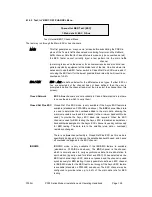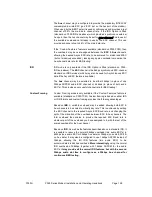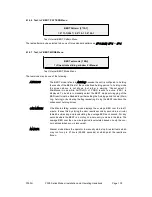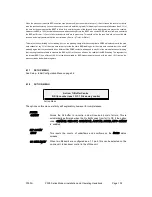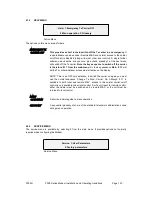
P300H
P300 Series Modem Installation and Operating Handbook
Page 142
8 APPLICATION NOTES
8.1 DOPPLER & PLESIOCHRONOUS BUFFERING
There are two terms commonly used when referring to the receive buffering, namely Doppler and
Plesiochronous.
Doppler:
Receive Doppler buffering is required because the incoming data from the
satellite is subject to Doppler shift, which occurs in an approximately 24 hour
cycle. The Doppler shift is due to the satellite movement relative to the earth
and is directly proportional to its station keeping accuracy. Towards the end of
a satellites life when its station keeping is degraded to save fuel, the Doppler
shift on incoming signals increases and buffers may have to be increased in
size. The receive buffer acts as a elastic store or FIFO (First In First Out
memory) gradually emptying and filling to absorb the difference over the 24
hour period. If the clock signals within the system all originate from one source,
then the buffer will never be exceeded, it will simply slowing filling and emptying
over this 24 hour cycle.
Plesiochronous:
This refers to buffering needed when there is more than one clock in the
system and a buffer is required to absorb the difference between the two
clocks. Typically data is placed into the buffer with one clock, and removed with
another, thus causing a gradual
continuous
filling
or
emptying of the buffer,
causing slips on a regular basis. The period between buffer slips (when it is
totally full or empty) will be constant, and proportional to the difference between
the two clocks.
A buffer will provide both functions
, it simply depends on how the system clocking is arranged
whether it provides Doppler buffering, or a combined Doppler and Plesiochronous buffering (if there are
two clocks in the system). Typically a buffer used for a Plesiochronous system is set larger than a
Doppler only buffer, as it has to accommodate a steady filling/emptying plus a superimposed daily cycle.
The slips, both underflows (-Ve) and Overflows (+ve) are displayed on the Detailed Rx Status screen.
Approximately equal counts indicate the buffer is too small to accommodate the incoming Doppler shift
(2ms is usually sufficient). One count significantly higher than the other indicates that the buffer is
slipping due to a large difference in the clock from the satellite and the buffer output clock. With
typical
earth station clock accuracies, buffers never need be larger than approximately 16ms.

